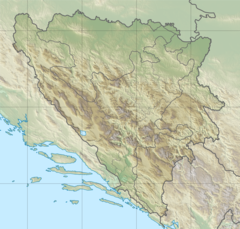
Stephen Tvrtko I was the first king of Bosnia. A member of the House of Kotromanić, he succeeded his uncle Stephen II as the ban of Bosnia in 1353. As he was a minor at the time, Tvrtko's father, Vladislav, briefly ruled as regent, followed by Tvrtko's mother, Jelena. Early in his personal rule, Tvrtko quarrelled with his country's Roman Catholic clergy but later enjoyed cordial relations with all the religious communities in his realm. After initial difficulties – the loss of large parts of Bosnia to his overlord, King Louis I of Hungary, and being briefly deposed by his magnates – Tvrtko's power grew considerably. He conquered some remnants of the neighbouring Serbian Empire in 1373, after the death of its last ruler and his distant relative, Uroš the Weak. In 1377, he had himself crowned king of Bosnia and Serbia, claiming to be the heir of Serbia's extinct Nemanjić dynasty.

Visoko is a city located in the Zenica-Doboj Canton of the Federation of Bosnia and Herzegovina, an entity of Bosnia and Herzegovina. As of 2013, the municipality had a population of 39,938 inhabitants with 11,205 living in Visoko town. Located between Zenica and Sarajevo, Visoko lies where the river Fojnica joins the Bosna.

The House of Kotromanić was a late medieval Bosnian noble and later royal dynasty. Rising to power in the middle of the 13th century as bans of Bosnia, with control over little more than the valley of the eponymous river, the Kotromanić rulers expanded their realm through a series of conquests to include nearly all of modern-day Bosnia and Herzegovina, large parts of modern-day Croatia and parts of modern-day Serbia and Montenegro, with Tvrtko I eventually establishing the Kingdom of Bosnia in 1377. The Kotromanić intermarried with several southeastern and central European royal houses. The last sovereign, Stephen Tomašević, ruled briefly as Despot of Serbia in 1459 and as King of Bosnia between 1461 and 1463, before losing both countries – and his head – to the Ottoman Turks.
Bošnjani, meaning Bosnians, is the name originating from the Middle Ages, used for the inhabitants of Bosnia. The name is used and can be found in Bosnian written monuments from that period, appearing in Venetian sources as earliest as 12th century, according to investigation of the relations between Bosnia and Venetia by historian Marko Šunjić, and other documents until at least early 16th century and the Ottoman conquest and power stabilization.

Hrvoje Vukčić Hrvatinić was a medieval Bosnian nobleman and magnate, Grand Duke of Bosnia, Knez of Donji Kraji, and Duke of Split. He was the most prominent member of the Hrvatinić noble family, and one of the major feudal lords in Kingdom of Bosnia. He was Grand Duke of Bosnia under three Bosnian kings: King Tvrtko I, King Stephen Dabiša and King Stephen Ostoja. In 1403, and after Tvrtko I's death, Ladislaus of Naples named him his deputy for Dalmatia, and bestowed him with a title Duke of Split, later Herzog of Split. He played a crucial role in the dynastic struggles between the Anjou and Luxembourg claimants to the Hungarian-Croatian throne at the end of the 14th century, as well as in the emergence of the Bosnian Kingdom as a regional power during the same period.
Stephen Ostoja was King of Bosnia from 1398 to 1404 and from 1409 to 1418.

The area of today's Visoko is considered to be a nucleus from where Bosnian statehood was developed in 10th century. The expanded valley of the river Bosna around today's Visoko was the biggest agriculture area in central Bosnia, so fertile ground around Visoko was ideal for development of early political center of Bosnian nobility.

Usora was important zemlja of the medieval Bosnian state, first banate and later kingdom, although it also had some periods outside its jurisdiction and royal authority, when it was connected with neighboring banates of Slavonia, or Mačva at times. The administrative seat of this zemlja was Srebrenik, which also served as residence for its rulers for entire period of existence of the medieval Bosnian state. It took its name from the river Usora.
Kujava Radinović was the second wife of King Stephen Ostoja of Bosnia and as such she was Queen of Bosnia from 1399 to 1404 and again from 1409 to 1415. She was the daughter of the nobleman Radin Jablanić.

The Banate of Bosnia, or Bosnian Banate, was a medieval state based in what is today Bosnia and Herzegovina. Although Hungarian kings viewed Bosnia as part of Hungarian Crown Lands, the Banate of Bosnia was a de facto independent state for most of its existence. It was founded in the mid-12th century and existed until 1377 with interruptions under the Šubić family between 1299 and 1324. In 1377, it was elevated to a kingdom. The greater part of its history was marked by a religiopolitical controversy revolving around the native Christian Bosnian Church condemned as heretical by the dominant Chalcedonian Christian churches, namely the Catholic and Eastern Orthodox churches, with the Catholic Church being particularly antagonistic and persecuting its members through the Hungarians.

The Kingdom of Bosnia, or Bosnian Kingdom, was a medieval kingdom that lasted for nearly a century, from 1377 to 1463, and evolved out of the Banate of Bosnia, which itself lasted since at least 1154.

The Miloradović or later Stjepanović (Стјепановић), whose paternal parent house was Hrabren (Храбрен), were an Eastern Orthodox Bosnian Vlach noble family and a katun clan from Hum, and later Sanjak of Herzegovina, parts of present-day Bosnia and Herzegovina, and whose some later branches embraced the Bosnian Serb ethnic identity, while others converted to Islam and became Bosnian Muslims. The members of the family served the Kingdom of Bosnia, the Republic of Ragusa, and the Ottoman Empire. One branch of the Miloradović's established themselves as military leaders of Russian Empire and were adopted into the Russian nobility. The family left behind several cultural-historical monuments important to Bosnian and Herzegovinian heritage, protected as such by the KONS state agency and the UNESCO.

The name of Bosnia is commonly used in English language as an exonym Bosnia, representing the South Slavic common endonym Bosna. The name was first recorded during the 10th century, in the Greek form Βόσονα, designating the region. In following centuries, the name was used as a designation for a Bosnian medieval state. After the Ottoman conquest in 1463, the name continued to be used as a designation for the Sanjak and Eyalet of Bosnia. After the Austro-Hungarian occupation in 1878, the region of Bosnia was reorganized and the name of its region of Herzegovina incorporated into the dual name of Bosnia and Herzegovina.

Dubravko Lovrenović was Bosnian and Herzegovinian medievalist, author and essayist, who worked at the Faculty of Philosophy of the University of Sarajevo, Department of History, in Sarajevo, Bosnia and Herzegovina.

Royal Court in Sutjeska was a medieval Bosnian court, residence and administrative seat of the Bosnian king, from mid-fourteenth to mid-fifteenth century, located in present-day Kraljeva Sutjeska, Bosnia and Herzegovina. The compound consisted of several buildings, chapel, and the nucleus of what will later become Kraljeva Sutjeska Franciscan Monastery.

Pavao Anđelić (1920-1985) was a Bosnian lawyer, archaeologist and historian. He mainly studied the history of medieval Bosnia and is noted for archeological work done at Mile and historically rich areal surrounding modern town of Visoko, as well as Kraljeva Sutjeska and Bobovac.

The Humska Zemlja, also Hum, is a historical zemlja that arose in the Middle Ages as well-defined administrative unit of medieval Bosnia ruled by the Kosača dynasty. It included most of today's Herzegovina, in Bosansko Primorje including Konavle, territories on the south of Dalmatia between Omiš and Neretva Delta, in Boka Kotorska and south to Budva. The name for this zemlja is taken from the earlier name for the region, Zahumlje. The seat of Kosače family was in the town and fortress of Blagaj and during the winter seasons, Novi.

Kraljeva Sutjeska is a village in the municipality of Kakanj, Bosnia and Herzegovina. The village has historical significance and rich heritage, and during the Middle Ages it used to be a capital of medieval Bosnian state.
The Pribinić family, also Radosalić family or Radosalić–Pribinić family, were a prominent medieval Bosnian noble family, a holder of the hereditary honor, which ruled over the medieval župa of Lepenica, a part of the medieval Bosnian state. Župa Lepenica was located in central Bosnia and included modern day's towns of Kiseljak, Fojnica and Kreševo. The Lepenica was mentioned for the first time in 1244 in the charter of the Hungarian king Bela IV, along with other parishes that existed in the area of central Bosnia.
Mastan Bubanjić was a member of the medieval Bosnian noble family of Masnović. As a prominent member of a state noble family, rusag's nobility, he beared a title of duke (vojvoda), and had a seat in Drežnica. His legacy includes a rock-inscription on the rock-face in Donja Drežnica, between Jablanica and Mostar, present-day Bosnia and Herzegovina. The inscription is declared a National Monument of Bosnia and Herzegovina by KONS in 2006.


















